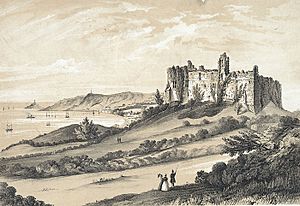Oystermouth Castle facts for kids
Quick facts for kids Oystermouth Castle |
|
|---|---|
| Oystermouth, Swansea, Wales | |

Oystermouth Castle
|
|
| Type | Castle |
| Site information | |
| Owner | City and County of Swansea council |
| Open to the public |
Yes |
| Condition | Ruin |
| Site history | |
| Built | 12th century |
| In use | 1106 to about 1650 |
| Materials | Stone |
|
Listed Building – Grade I
|
|
Oystermouth Castle (Welsh: Castell Ystum Llwynarth) is an old stone castle in Wales. It was built by the Normans, who were people from Normandy, France. The castle stands proudly overlooking Swansea Bay, near the village of the Mumbles.
Contents
The Castle's Early Days
The first castle here was built by a Norman lord named William de Londres around 1106. This was soon after the Normans took control of the Gower area.
However, the Welsh people of Deheubarth (a Welsh kingdom) fought back. In 1116, they took over Gower and made William de Londres run away. They even burned down his castle!
But the castle was rebuilt quickly. Sadly, it was probably destroyed again in 1137 when the Welsh took Gower once more.
The family who owned the castle, the Londres family, eventually died out in 1215. At this time, the Welsh, led by the powerful Prince Llywelyn the Great, took control of Gower again.
In 1220, the Welsh were pushed out of the area. The King of England, Henry III of England, gave the Gower region back to John de Braose. He then rebuilt both Swansea Castle and Oystermouth Castle.
The De Braose Family Takes Over
During the 1200s, the de Braose family were the powerful Lords of Gower. They owned many castles, including Oystermouth, and had lots of land. Because they were so wealthy, the de Braose family could afford to rebuild Oystermouth Castle using strong stone.
They added a tall outer wall, buildings inside, and even a chapel. The castle also had three-story living areas with fireplaces and garderobes (which were like old toilets) on each floor. This meant people could live there in comfort. The castle was also made much stronger for defense.
By the end of the 1200s, Oystermouth Castle became their main home, even more important than Swansea Castle. The King of England, Edward I of England, even visited briefly in December 1284.
However, by 1331, the Lords of Gower started living elsewhere. This meant the castle became less important during the 1300s.
The daughter of the last de Braose Lord, Aline de Breos, made the chapel even better. It became one of the most beautiful chapels in any castle in south Wales. Aline later married John de Mowbray. This is how the ownership of Gower and Oystermouth Castle passed to the de Mowbray family. After them, it went to the Herbert family, and then to the Somersets, who became powerful Dukes.
Falling Apart and Being Saved
After the Middle Ages (around the 1500s), the castle slowly started to fall apart. In 1650, a report about Gower described Oystermouth Castle as "an old decayed castle." It said it was "of no use, but of a very pleasant situation." This means it was a ruin, but in a nice spot.
In the 1700s, artists often painted the castle because it looked like a beautiful ruin. Later, in the 1840s, a local historian named George Grant Francis helped restore parts of it. At that time, the Duke of Beaufort owned the castle.
In 1927, the Duke of Beaufort gave the castle to the local government, which was then called Swansea Corporation. Today, the City and County of Swansea council looks after the castle.
Modern Restoration (2000s)
In 2009, the Welsh government, called the Senedd, announced they would spend a lot of money to improve heritage sites in Wales. This was to help attract more tourists.
As part of this plan, Oystermouth Castle closed in 2010 for a big renovation that cost £1 million. It reopened to visitors in July 2011.
The restoration work included new facilities for visitors and a special space for education. They also improved how people could get around the castle. One exciting addition is a 30-foot-high glass viewing platform and bridge. This bridge leads to Alina's Chapel, letting visitors see it up close.
Cool Features of the Castle
If you look at the entrance gate, you'll see the walls curve inwards. This shows that there were plans to build two round towers into the gatehouse (the main entrance building). We don't know if these towers were ever actually built.
The chapel is on the second floor of the chapel building. It has beautiful windows from the 1300s with fancy stone patterns. Local stories say that Aline de Mowbray herself oversaw the building of this chapel.
Recently, during conservation work, parts of an amazing medieval painting were found in the chapel. This painting is thought to be over 700 years old! Even though time has damaged it, experts believe it shows a double-arched canopy with figures of angels. You can still see a wing with many feathers and round shapes that look like a head with yellow hair and a halo. This painting is very important. It shows how beautiful the chapel was when Alina de Breos designed it in the early 1300s. It was probably part of a much larger artwork.
Castle's Namesake
During World War II, the British Royal Navy had a ship called HMT Oystermouth Castle. It was a naval trawler, a type of fishing boat used by the navy.




